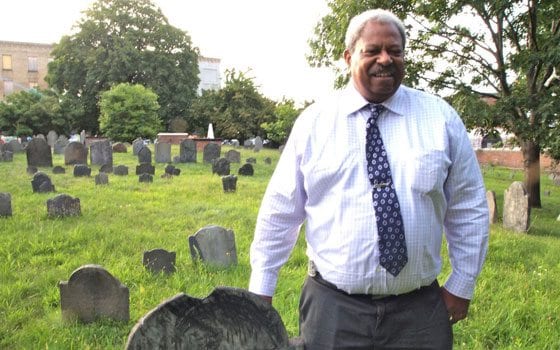

Author: Yawu MillerRoxbury Highlands Historical Society President Thomas Plant examines colonial history in the Eliot Burying Ground. HBI, which has its headquarters next door to the cemetery, is hoping to make the burial ground open to the public soon.
Much has changed in Roxbury since the Puritans founded the town in what was then the Massachusetts Bay Colony in 1630.
There are no buildings remaining from the 1600s and much of the topography and coastline of Roxbury has been radically altered as hills were leveled to fill in the South Bay.
The only place where early Puritan history has been preserved in Roxbury is in the Eliot Burying Ground (formerly known as Old Roxbury Burying Ground and Eustis Street Burying Ground), a small, often overlooked cemetery in Dudley Square, surrounded by a stone wall topped with a wrought iron fence.
The tombstones of colonists buried in the early days of Roxbury are the oldest extant man-made objects above ground in Roxbury. While nearly 400 years of history has taken its toll on the cemetery, many of the headstones remain in the exact location they occupied when the remains of the colonists were interred.
“Remarkably, a lot of these headstones are in good shape,” says Thomas Plant, president of the Roxbury Highlands Historical Society.
While the cemetery has long been closed to the public, Historic Boston Incorporated (HBI), which renovated a firehouse adjacent to the burial ground, is planning to re-open it to visitors.
“We’re glad they’re here to help with the cemetery,” Plant said. “There’s all this history you can find here – stories about how people lived and died.”
Residing in the cemetery are the remains of many prominent colonists including Massachusetts Governor Thomas Dudley, who was buried there in 1653 and John Eliot, the Puritan pastor who translated the Bible into the Algonquin language.
The grave markers of the early colonists bear simple inscriptions. Names, dates of birth and death and are crowned with winged skulls which symbolize the soul taking flight.
The slate gravestones of prominent colonists such as Dudley, Seaver, Williams and Perrin serve as an historical record of Roxbury.
“It has been pretty well preserved so far,” says State Rep. Byron Rushing, former president of the Museum of African American History. “People just left it alone.”
The colonial-era burial grounds in downtown Boston have had their stones unearthed and rearranged in neat rows, but most of the stones in the Roxbury cemetery have remained in the same position since the first marker was set in 1633.
The deaths recorded on the stone markers tell much of the history of the early colony, infant deaths, small pox outbreaks, soldiers killed in the King Philips War, the French and Indian War, the Revolutionary War and the War of 1812.
That the burial ground has survived in such great condition is somewhat of a miracle, given the forces of history.
One of the greatest threats to the burial ground came during the British siege of Boston in 1775, when colonists constructed a redoubt along what are now Eustis and Williams Streets, placing soldiers and artillery in the cemetery among the tombstones and putting the cemetery in the line of cannon fire.
According to historical records, artillery fire shattered the peace of eternal repose on the afternoon and night of June 17. But there was no significant damage to the burial ground.
In later years the burial ground survived the enlargement of Washington and Eustis Streets, the construction of an adjacent factory and firehouse and then the roar of overhead trains on the elevated Orange Line.
The stone wall and cast-iron fencing encircling the burial ground helped suppress foot traffic and vandalism over the following decades.
In the 1920s and 1930s, when blacks began moving to Roxbury from Beacon Hill, they brought with them a respect for the colonial history of Roxbury, according to Rushing.
“When black people moved here, they brought this sense of taking over the history of the neighborhood,” Rushing said.
While the burial ground stands as the oldest remnant of the city’s Puritan past, in nearby Eliot Square, the Dillaway-Thomas House, home to John Thomas, an American commander in George Washington’s Continental Army, became the centerpiece of the federally designated Roxbury Heritage State Park through Rushing’s efforts.
On the other side of Roxbury, off Dudley Street, the Shirley-Eustis House, which was built between 1747 and 1751, by Massachusetts Bay Colony Governor William Shirley, stands as one of just four remaining colonial era governor’s mansions in the United States. In 1991, the house opened to the public as a national historic landmark.
HBI executive director Kathy Kottaridis said she hopes to open the burial ground to the public in the near future. The nonprofit is in talks with the city’s Parks and Recreation Department about managing access to the cemetery during weekdays.
Rushing advocates keeping the burial ground open to the public on a daily basis, but said HBI should always have a pair of eyes on the cemetery.
“People should always be able to get into the cemetery, but you want to cut down on vandalism as much as possible,” he said.






